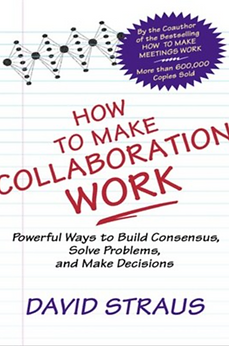

Thoughts from Linda:
How To Make Collaboration Work
Powerful Ways to Build Consensus, Solve
Problems and Make Decisions
David Straus
I am delighted to review this book for our website for March!
David is a friend and mentor, and I have known him since 1993 when I was introduced to the consulting firm he launched, Interaction Associates, in Boston. I went on to join the firm in 1994 and subsequently succeeded him as the 2nd Chair of the Board and then, took the role of President and CEO in 2001. I served in this role (in addition to being one of several owners of the firm) until 2011 and today represent the firm in our company, DNA Consulting.
This book follows his first book, written in 1969, How to Make Meetings Work. That book launched the company and is still in print today. This book, How to Make Collaboration Work, was written in 2002. The company, Interaction Associates (IA), is today a consultancy and training firm, located in Boston, focused on the book’s title: i.e., in today’s world, HOW do you make this incredible and appealing concept/philosophy a reality from a practical approach? The book will tell you HOW. Just like the firm, IA, it has a practical bent, while being based on well-researched and developed theory.
As Tom Layton mentions in the Forward to this book, in 1971 when IA was just getting launched, the term ‘facilitator’ was not a common term and the word, collaboration, actually still carried the vestiges of its WWII meaning. Sharing power and working to achieve an open and transparent environment at work were young concepts. David’s work was ground-breaking and quite advanced for the time. The whole concept of ‘group process management’ was pioneered by the firm and today this organization still is the ‘gold standard’ for transferring skills and demonstrating the power of collaboration in action.
I have read and re-read this book over the years and I always see something new in it each time. As a practitioner of David’s work, it is still thrilling to me to hear ‘his voice’ telling the story of these ‘few powerful ideas’ and realizing that I have had the incredible gift in my life to be able to bring these ideas and tools to so many people over the years. As he notes in his Preface, “the book is organized around a few powerful ideas, or principles, that, if grasped in your heart and mind, will allow you to harness the power of collaborative action for yourself and your group, organization or community.”
David goes on to note that collaboration does not exist in a values-free zone; in fact, it is based on a set of values, which as Brian Hall notes in the second book being reviewed this month, Values Shift, include human dignity and interdependence. I’ll have more to say about these in the review of Values Shift. The key point is that proper intentions and heart sets/mind sets need to be in place for the real deal of collaboration to be brought to life. As with any set of tools & practices, they can be used for good or in a manipulative way.
I have had people tell me occasionally that this book seems ‘so simple.’ “I say YES it is!” And, in fact any classic principle/philosophy one could argue is simple. Oliver Wendell Holmes Jr. is quoted as having said, “I would not give a fig for the simplicity this side of complexity, but I would give my life for the simplicity on the other side of complexity.”
In the terms of values, Brian Hall’s definition of ‘minessence’ comes to mind for me when working with David’s work. That definition is: “The capacity to miniaturize and simplify complex ideas or technological instruments (tools) into concrete and practical objectifications in a way that creatively alters the consciousness of the user.”
David’s classical training as an architect and his own collaborative nature set him up well to convey the ‘few powerful ideas’ via stories and simple graphics, that cut across languages and cultures. I know this because I have taught the Facilitative Leadership work all over the world, only to learn that people immediately see the tools as usable immediately to help them work with others in ways that enrich the lives of all. The graphical representations are universally understood and are easy to access mentally.
The book is organized into three parts: Part I deals with the meta level of thought around human problem-solving and the heuristics of that concept. This is very important to cover prior to moving into the other two parts of the book. Part II will take you into the ‘5 principles of collaborative problem solving’ and they are just as relevant today as they were in 2002. Finally, Part III looks at systemic collaboration as a vision for leaders at all levels to embrace.
Let me end with this quote from David, from page 10 of the book:
“The place to begin working collaboratively is in your heart. Try to hold in your heart two powerful ideas: 1. Every human being has the right to be involved in decisions that affect her or his life, and 2. With good process, people can generate more creative and comprehensive solutions collaboratively than they can by themselves.
Mastery of the tools and techniques essential for successful collaboration will follow. With learning and practice, you can make collaboration work for you.
It’s effective, it’s energizing and it is the right thing to do.”
I suggest that reading this book is ‘the right thing to do!’